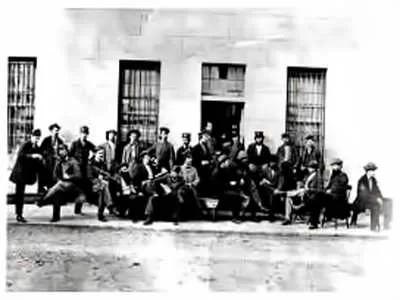On Georges Island in Boston Harbor, a pentagonal-shaped fort named Fort Warren stands as a testament to America’s turbulent history. Built in 1833, its primary purpose was to protect the main shipping channels leading into Boston.
The fort was named after Dr. Joseph Warren, a patriot leader who played a significant role at the dawn of the American Revolution by dispatching Paul Revere and William Dawes to warn the colonies of the advancing British troops. Completed in the mid-1860s, Fort Warren served various roles, but it was during the Civil War that it became the setting for one of its most tragic tales — the story of Melanie Lanier and her desperate attempt to rescue her husband.
A Daring Plan: Melanie Lanier’s Risky Mission
Melanie Lanier’s story unfolds in the shadow of Fort Warren, where her husband, Lieutenant Samuel Lanier, a young Confederate soldier, had been captured at Roanoke Island and taken as a prisoner. Upon learning of his capture, Melanie, determined to free him, set out from Georgia to Hull, Massachusetts. There, she sought the assistance of a Confederate sympathizer and prepared for her daring mission by cutting her hair short and disguising herself in a Union soldier’s uniform. Armed with an old pepperbox pistol and a pick-ax, Melanie intended to sneak into the fort and free her husband.

For days, she observed Fort Warren from a distance with a spyglass, carefully studying the patrols and routines of the guards. Then, on a stormy January night in 1862, she seized her opportunity. Disguised as a man, she rowed across Boston Harbor to Georges Island, slipping past Union sentries undetected. Reaching the fort’s walls, she signaled her husband, and he and several other Confederate prisoners hoisted her up through a musket hole.
The Escape That Went Terribly Wrong
Inside the fort, Lieutenant Lanier and a group of Confederate prisoners were secretly digging a tunnel to the center of the fort. Their plan was to emerge, overpower the guards, and seize their weapons. However, their hopes for freedom were dashed when Union soldiers on the other side of the wall overheard the digging and alerted their commanding officer, Major Justin E. Dimick. The Union troops surrounded the tunnel exit, capturing the prisoners as they emerged.

Thinking quickly, the remaining men inside the tunnel devised a new plan. They would surrender, hoping that Melanie, with her pistol, could use the element of surprise to force the Union soldiers to stand down. The plan seemed to work initially; Melanie sprang from the tunnel, pointing her pistol directly at Major Dimick. He raised his hands as if in surrender, but as he approached, he suddenly lunged forward and struck the gun from her hand. The pistol fired, and the bullet tragically struck and killed her husband.
A Tragic End: The Lady in Black’s Execution
Melanie was immediately arrested, tried as a spy, and found guilty. She was condemned to hang, a harsh sentence that could have been avoided if she had only been charged with assisting her husband’s escape. Her final request was to be buried in a dress, but the only garment resembling women’s clothing at the fort was an old black cloak used in a cadet play. She was hanged on February 2, 1862, and buried in that cloak.
Her tragic story did not end with her death. Shortly after her execution, strange sightings began to be reported by the soldiers stationed at Fort Warren. Richard Cassidy, a witness to her hanging, described a chilling encounter while patrolling near the site of the execution. He felt a sudden, cold touch and turned to see a woman dressed in black. Other soldiers soon reported similar sightings of a ghostly figure in black walking the parapets and ramparts at night.
The Haunting of Fort Warren: The Legend of the Lady in Black
The ghost of Melanie Lanier soon became known as the “Lady in Black.” Stories of her spectral appearances spread quickly. Soldiers reported shooting at a mysterious black figure that would disappear into thin air. Many claimed to hear a female voice warning them to stay away from a place called the Corridor of Dungeons. These warnings were so convincing that some soldiers refused to enter that area.

One account involved four officers who discovered the footprints of a woman in freshly fallen snow near the entrance to the fort. Another report detailed soldiers playing poker in a storeroom who saw stones rolling across the floor with no apparent cause. One soldier was even court-martialed for abandoning his post, claiming that he had been chased by the Lady in Black’s ghost. As recently as World War II, a soldier stationed at the fort reported seeing her apparition, leading to a nervous breakdown.
Fort Warren Today: A Historical and Haunted Destination
Today, Fort Warren is maintained by the Department of Conservation and Recreation and is the centerpiece of the Boston Harbor Islands, now a national park area. Each summer, thousands of tourists visit this historic site, drawn by both its rich Civil War history and its reputation as one of Boston’s most haunted locations. Despite the passage of time, stories of the Lady in Black continue to capture the imagination of visitors and locals alike. Even though no soldiers are stationed at Fort Warren today, there are still occasional reports of sightings of the Lady in Black.
The ghostly presence of Melanie Lanier, forever clad in that black cloak, seems destined to roam the fort’s dark corridors, ensuring that her story of love, bravery, and tragedy will never be forgotten.

